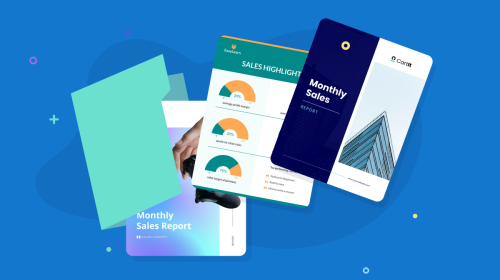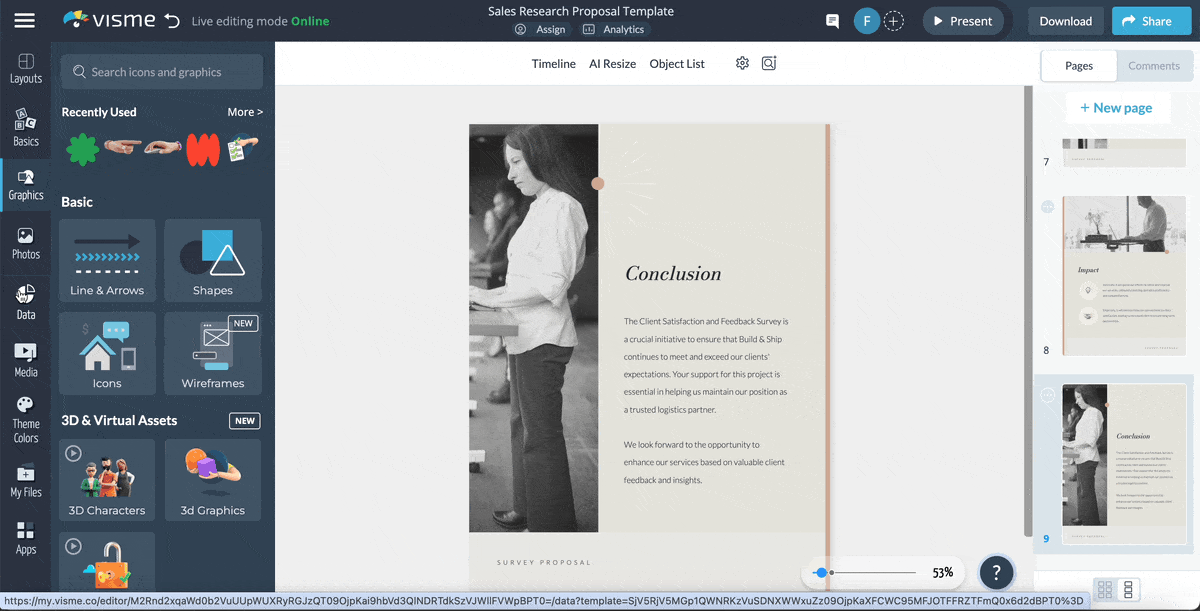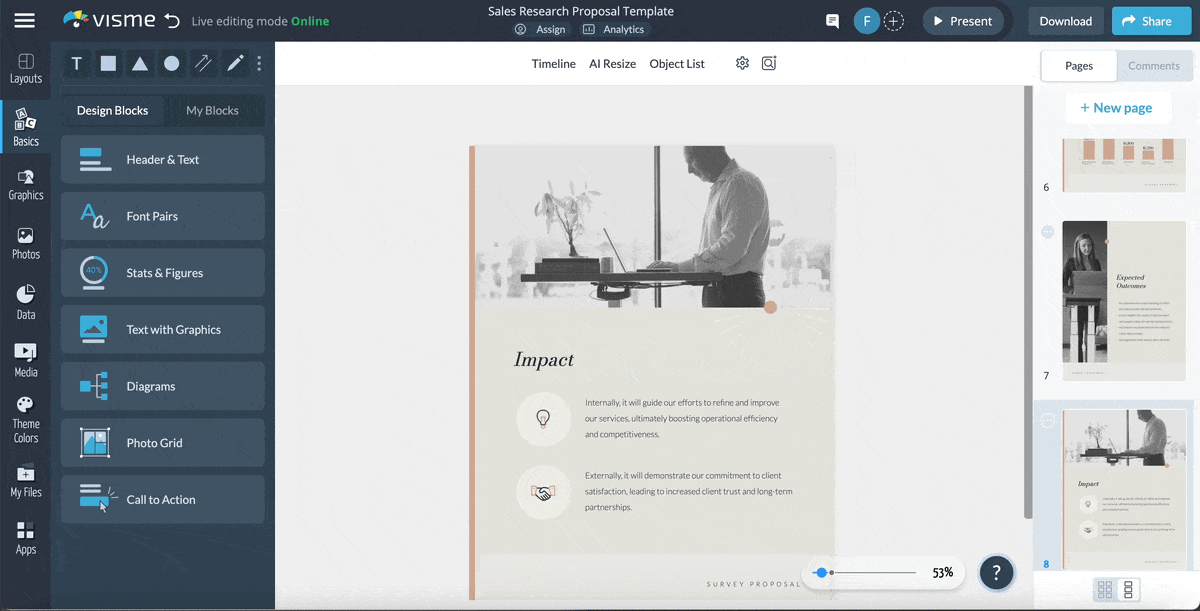
10 Research Proposal Examples & Template to Use


So you have a groundbreaking research idea you've spent months or even years developing, and now you're ready to take the next step.
How do you get funding for your research, and how should you approach potential funders? The answer is to create a convincing research proposal.
Unfortunately, most research proposals often get rejected. According to the European Research Council, the success rate for repeat proposal applications was only 14.8% in 2023.
Pitching a novel research concept isn’t enough. To increase your chances of securing funding, your proposal must check the right boxes in terms of clarity, feasibility, aesthetic appeal and other factors.
If you’re looking for inspiration to create a persuasive and feasible proposal, you’re in the right place. In this article, we have compiled a list of research proposal examples to help you create yours.
These examples will help you understand how to organize your proposal, what information to include and how to present it in a way that encourages others to support your project.
Let's dive in!
A research proposal is a structured document that outlines the core idea of your research, the methods you intend to use, the required resources and the expected results.
Think of it as a sales pitch for your research. It answers some big questions: What are you planning to explore? Why is it important to conduct the research? What are your research objectives and the methods you’ll use to achieve them? What are the potential outcomes or contributions of this research to the field?
A research proposal serves two primary purposes. First, it convinces funding bodies or academic committees to support your research project expected to bring new ideas and insights. Second, it provides a roadmap for your research journey, helping you stay focused, organized and on track.
Now, we'll discuss what to include in proposal. You'll learn about the important parts of a research proposal template and how they help present your research idea clearly.
Here’s an research proposal example infographic that you can use to understand the elements quickly.
Start your proposal with a title page that clearly states your research. The title page is like a book cover, giving the first impression of your project. Therefore, you must ensure the design is engaging enough to attract your audience at first glance.
Include the following details on your title page:
After the title page comes the abstract and the table of contents.
The abstract is a concise summary of your project that briefly outlines your research question, the reasons behind the study and the methods you intend to use. It is a quick way for readers to understand your proposal without reading the entire document.
The table of contents is a detailed list of the sections and subsections in your proposal, with page numbers. It helps readers navigate through your document and quickly locate different parts they're interested in.
The introduction of your proposal sets the tone for the rest of the document. It should grab the reader's attention and make them want to learn more. It's your chance to make a strong case for why your research is worth investigating and how it can fill a gap in current knowledge or solve a specific problem.
Make sure that your introduction covers the following:
A literature review is a list of the scholarly works you used to conduct your research. It helps you demonstrate your current knowledge about the topic.
Here's how this part works:
This section outlines your plan for answering your research question. It explains how you intend to gather and analyze information, providing a clear roadmap of the investigation process.
Here are the key components:
Describe the entire group you're interested in (the population). This could be all teachers in a specific state or all social media platform users. After that, you will need to explain how you will choose a smaller group, known as a sample, to study directly. This sample should be selected to accurately represent the larger population you are interested in studying.
To choose the right sampling method, you need to assess your population properly. For instance, to obtain general insights, you can use random sampling to select individuals without bias. If the population consists of different categories, such as professionals and students, you can use stratified sampling to ensure that each category is represented in the sample.
Other popular sampling methods include systematic, convenience, purposive, cluster, and probability sampling techniques.
There are three main approaches for the research: qualitative (focusing on experiences and themes), quantitative (using numbers and statistics), or mixed methods (combining both). Your choice will depend on your research question and the kind of data you need.
This section details the specific methods you'll use to gather information. Will you distribute surveys online or in person? Conduct interviews? Perhaps you'll use existing data sets. Here, you'll also explain how you'll ensure the data collection process is reliable and ethical.
Once you have collected your data, the next step is to analyze it to obtain meaningful insights. The method you choose depends on the available data type.
If you have quantitative data, you can employ statistical tests to analyze it. And if you're dealing with qualitative data, coding techniques can help you spot patterns and themes in your collected data.
In this section, you need to explain how your research will contribute to the existing knowledge in your field. You should describe whether your study will fill a knowledge gap, challenge conventional ideas or beliefs or offer a fresh perspective on a topic.
Clearly outline how your work will advance your field of study and why this new knowledge is essential.
Create a timeline with important milestones, such as finishing your literature review, completing data collection and finalizing your analysis.
This shows that you've carefully considered the scope of your project and can manage your time effectively. Furthermore, account for possible delays and be prepared to adapt your schedule accordingly.
To create this timeline, consider using a visual tool like a Gantt chart or a simple spreadsheet. These tools will help you organize individual tasks, assign deadlines, and visualize the project's overall progress.
Choose a Gantt chart template from Visme's library and customize it to create your timeline quickly. Here's an example template:
The budget section is your opportunity to show them that you've carefully considered all necessary expenses and that your funding request is justified.
Here's how you can approach this part:
Using these research proposal examples and templates, you can create a winning proposal in no time. First you'll find templates for various topics and customize every aspect of them to make them your own. Then we'll dive into two real-life research proposal examples below.
Visme’s drag-and-drop editor, advanced features and a vast library of templates help organizations and individuals worldwide create engaging documents.
Here’s what a research student who uses Visme to create award-winning presentations has to say about the tool:
Research Student
Now, let’s dive into the research proposal examples.
This research proposal presentation template is a powerful tool for presenting your research plan to stakeholders. The slides include specific sections to help you outline your research, including the research background, questions, objectives, methodology and expected results.
The slides create a coherent narrative, highlighting the importance and significance of your research. Overall, the template has a calming and professional blue color scheme with text that enables your audience to grasp the key points.
If you need help creating your presentation slides in a fraction of the time, check out Visme's AI presentation maker. Enter your requirements using text prompts, and the AI tool will generate a complete presentation with engaging visuals, text and clear structure. You can further customize the template completely to your needs.
Sales research gives you a deeper understanding of their target audience. It also helps you identify gaps in the market and develop effective sales strategies that drive revenue growth. With this research proposal template, you can secure funding for your next research project.
It features a sleek and professional grayscale color palette with a classic and modern vibe. The high-quality images in the template are strategically placed to reinforce the message without overwhelming the reader. Furthermore, the template includes a vertical bar graph that effectively represents budget allocations, enabling the reader to quickly grasp the information.

Use Visme's interactive elements and animations to add a dynamic layer to your proposals. You can animate any object and add pop-ups or link pages for a more immersive experience. Use these functionalities to highlight key findings, demonstrate trends or guide readers through your proposal, making the content engaging and interactive.

This proposal template is a great tool for securing funding for any type of research project. It begins with a captivating title page that grabs attention. The beautiful design elements and vector icons enhance the aesthetic and aid visual communication.
This template revolves around how a specific user group adopts cryptocurrencies like Bitcoin and Ethereum. The goal is to assess awareness, gauge interest and understand key factors affecting cryptocurrency adoption.
The project methodology includes survey design, data collection, and market research. The expected impact is to enhance customer engagement and position the company as a customer-centric brand.
Do you need additional help crafting the perfect text for your proposal? Visme's AI writer can quickly generate content outlines, summaries and even entire sections. Just explain your requirements to the tool using a text prompt, and the tool will generate it for you.
Creating a product that delights users begins with detailed product research. With this modern proposal template, you can secure buy-in and funding for your next research.
It starts with a background that explains why the research is important. Next, it highlights what the research is set to achieve, how the research will be conducted, how much it will cost, the timeline and the expected outcomes. With a striking color scheme combining black, yellow, and gray, the template grabs attention and maintains it until the last page.
What we love about this template is the smart use of visuals. You'll find a flowchart explaining the methodology, a bar graph for the budget, and a timeline for the project. But that’s just the tip of the iceberg regarding the visual elements you’ll find in Visme.
Visme offers data visualization tools with 30+ data widgets, such as radial gauges, population arrays, progress bars and more. These tools can help you turn complex data into engaging visuals for your research proposal or any other document.
For larger data sets, you can choose from 20+ types of charts and graphs, including bar graphs, bubble charts, Venn diagrams and more.
If you’re a tech researcher, we’ve got the perfect template for you. This research proposal example is about predictive analytics in e-commerce. However, you can customize it for any other type of proposal.
It highlights the project's objectives, including the effectiveness of predictive analysis, the impact of product recommendations and supply chain optimization. The methods proposed for achieving these objectives involve A/B testing and data analysis, a comprehensive budget and a 12-month timeline for clear project planning.
The title page has a unique triptych-style layout that immediately catches the reader's attention. It has plenty of white space that enhances readability, allowing your audience to focus on the critical points.
Submitting to different funding agencies? You don’t have to manually make changes to your document. Visme's dynamic fields can help save time and eliminate repetitive data entry.
Create custom fields like project names, addresses, contact information and more. Any changes made to these fields will automatically populate throughout the document.
Artificial intelligence (AI) is taking the world by storm and the marketing niche isn’t left out. With this eye-catching template, you can attract attention to your proposed marketing research project for an AI-driven platform.
The main goal of the research is to evaluate the platform's feasibility and marketing potential. To achieve this goal, the scope of work includes a comprehensive analysis of the market and competitors and pilot testing. The proposal also contains a budget overview that clearly outlines the allocation of funds, ensuring a well-planned and transparent approach.
Using Visme's Brand Design Tool, you can easily customize this template to suit your branding with just one click. Simply enter your URL into the brand wizard, and the tool will automatically extract your company logo, brand colors, and brand fonts. Once saved, you or your team members can apply the branding elements to any document. It's that simple!
The environmental research proposal example focuses on carbon emissions, identifies their contributing factors, and suggests sustainable practices to address them. It uses an appropriate sample size and data collection techniques to gather and evaluate data and provide sustainable recommendations to reduce industrial carbon footprints and waste.
From a design standpoint, the green and white color combination matches the theme of nature and environmental friendliness. In addition to its aesthetic appeal, the proposal includes relevant images that support ecological advocacy, making it informative and visually aligned with its purpose.
A key feature of this template is its detailed breakdown of the project's timeline. It uses a Gantt chart to clearly present stages, milestones and deadlines.
Collaborate with your team members to customize these templates using Visme’s collaborative design features. These features allow you to leave feedback, draw annotations and even make live edits. Invite your teammates via email or a shareable link and allow them to work together on projects.
This research proposal template is a total game-changer - you can use it for any proposal and customize it however you want. It features a modern and refreshing color scheme that immediately makes it stand out, providing a contemporary look that can adapt to any project's needs.
The template's layout is thoughtfully designed with primary fields that users can easily personalize by changing text, adjusting colors, or swapping images. No matter the research topic, you can tailor the template to fit your specific needs.
Once you're done customizing your proposal template on Visme, you can download, share and publish it in different ways. For offline usage, you may download the proposal in PDF, PNG, or JPG format. To share it online, you can use a private or public link or generate a code snippet that you can embed anywhere on the web.
Want to create other types of proposals? Here are 29 sample proposal templates and 200+ business proposal templates that you can easily customize in Visme.
Now that we know what to include in a research paper as well as some amazing templates, here are some real-life research proposal examples that you can use to guide your own.
Granted these aren’t as well designed as the templates but use them as a frame of reference for the expected type of content that advisors or sponsors look for when making a decision.
York St. John University offers a collection of research proposal examples, including one titled Writing a Humanities PhD Proposal. This example is APA-formatted and aligned with the university’s research paper outline criteria, making it a great example for PhD students who need guidance before starting proposals.

This research proposal document includes not one but two examples of how to craft a compelling proposal. Created by The Open University’s Department of Social Policy and Criminology, the first example explores fathering after divorce or separation. It represents early thoughts on the topic, outlining clear interests and connecting them to ongoing debates.
The second example focuses on police governance and showcases a more developed proposal. It was created after the student had registered and collaborated with their supervisor to refine the ideas and methodology. To see the full document and both examples you can read more here.

Follow these steps to write a solid research proposal:
If you want to learn more about creating an expert research proposal, we highly recommend checking out our in-depth guide.
Your proposals can range from 1,000 to 5,000 words. For smaller projects or when specific requirements aren’t provided, aim for a concise and informative proposal that effectively outlines your research plan.
However, the ideal length depends on these factors:
The main purpose of a research proposal is to to convince advisors, funder raisers or sponsors, that your research topic or project is worthwhile, feasible, and well-planned. It’s essentially the elevator pitch for investors to use as an indicator on whether or not they should be interested in.
The difference between a research proposal and paper is that a proposal outlines the plan for a study, detailing objectives, methods, and significance. A research paper presents the findings and analysis of completed research.
The time it takes to write a research proposal depends on a few factors:
Set aside several weeks to a couple of months for researching, writing, and revising your proposal. Start early to avoid stress and produce your best work.
There are several factors that can make a proposal weak. Here are some of the most common errors that you should avoid while preparing your proposal:
Writing a compelling research proposal takes effort, but with the right tools, the process becomes a breeze. Use the research proposal examples and templates in this article as a launching point to write your own proposal.
The best part? Visme provides easy-to-use tools with a vast collection of customizable templates, design elements and powerful features. Plus, with Visme's AI tools for editing, designing and proposal generating you can streamline your workflow process faster than ever before!
Whether you're a seasoned researcher or a student, Visme has the resources to help you create visually appealing and well-structured proposals. In addition, Visme helps you create many other document types, such as presentations, infographics, reports and more.
Ready to create your own proposal? Check out Visme's proposal maker and start crafting professional and engaging proposals in minutes!
Design visual brand experiences for your business whether you are a seasoned designer or a total novice.
Try Visme for free